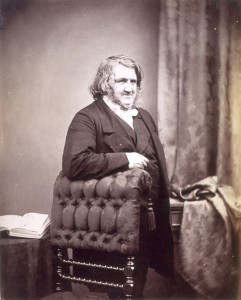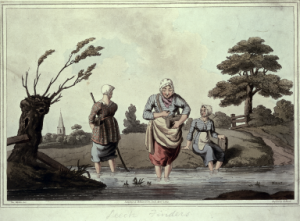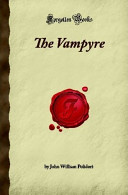“It may seem a strange principle to enunciate as the very first requirement in a Hospital that it should do the sick no harm.” – Florence Nightingale, Notes on Hospitals

Simpson, an obstetrician from Edinburgh, was the first to write about hospitalism. From Wikipedia Commons
The patient appeared comfortable in her ER bed. Too comfortable for an admission. Why admit an elderly woman, cancer patient at that, with normal labs, normal vital signs (except the fever) and probably a viral infection? Being in the hospital isn’t always a silver bullet.
“I have good news. I think you can go home.”
“My family already left, no one can take me home.”
“Oh, ok. I’ll be happy to help arrange a ride home.”
“Well, that nice woman said I had to stay, and that I would see an infection specialist, and I needed a CAT scan of my entire body, and I would get a private room, and… and…”
I certainly don’t mind keeping patients in the hospital in these situations. One night. It’s already late, what’s the harm?
“Ms. Smith, there’s a 20% chance you will get confused in the hospital and with an increased possibility you will leave with C diff. We will tether you to the bed with a Foley, IV Fluids, and compression devices, so if you don’t get a clot in your leg or a pressure ulcer from lying on your back for three days, you may fall when you trip over these tubes. However, you will be wearing red socks, which the hospital thinks will ward off falling, but, really it’s so when you do fall we can say, I told you so. See, I knew you needed red socks.”
Ok, that was my internal voice. I simply replied, “That’s fine, we can keep you overnight.”
But inside I saw HOSPITALISM loudly in my head. Hospitalism: a 19th century word. Unlike many “isms,” hospitalism doesn’t translate into a doctrine like humanism or creationism. It doesn’t relate to a field of study, like journalism, although journalism may also mean the fear of drowning amidst a mountain of unread medical periodicals. And it is not similar to Seussisms or it would mean rhyming hospital sayings, such as, “If you hear hooves, don’t think of zebras, but if you hear splish-splash, the blue fish crashed.” Or “The longer you stay, the longer you stay. The longer you stay, the more you pay.”
Hospitalism, first written down by Sir James Young Simpson, in 1869, refers to the medical miasma that was drunk with the wine served in 1800s hospitals. Home was safer. Simpson, an obstetrician from Edinburgh, was also the first to use chloroform during childbirth. He freed modern woman from, as Osler said about ether, “the Curse of Eve.”
Observing mortality rates between inner city hospitals and country hospitals after amputations, Simpson noted a death rate of 1 in 2.4 in large, urban hospitals compared to a 1 in 9.2 death rate for the much smaller country facilities. Simpson was rightly concerned about the patient being “endangered sometimes by the influence of morbific contagious material from the bodies of other inmates.” The carbolic acid of Lister to combat that morbific material was another 20 years away.

Three women gathering leeches. 1814. Used with permission. Science Museum / Science & Society Picture Library. wellcomeimages.org
His works were compiled by his son and can be found in the text Anesthesia, Hermaphroditism, and Hospitalism: an old tyme Sex, Drugs, and HACs ‘n Fall compilation. In addition to infection, painful purgatives, or tortuous topicals, another famous iatrogenic adverse event of the time was bloodletting: by needle or by leeches. Physician vampires at work. 42 million leeches ordered each year at Hotel Dieu in the early 1800s, with their official leech room, and able ankles of the leech collectors.
 It is appropriate, that another Edinburgh physician, Polidori, wrote the modern vampire story. He was a physician writer with powerful storyteller friends. Lord Byron’s physician and friend, he wrote The Vampyre during a ghost story contest, with Byron and the Shelleys. In 1816, at Villa Diodati, emerged Mary Shelley’s Frankenstein and the modern telling of the Nosferatu tale. (Perhaps Polidori was inspired by his own experience of bloodletting).
It is appropriate, that another Edinburgh physician, Polidori, wrote the modern vampire story. He was a physician writer with powerful storyteller friends. Lord Byron’s physician and friend, he wrote The Vampyre during a ghost story contest, with Byron and the Shelleys. In 1816, at Villa Diodati, emerged Mary Shelley’s Frankenstein and the modern telling of the Nosferatu tale. (Perhaps Polidori was inspired by his own experience of bloodletting).
With the development of anesthesia, and then antisepsis, the fears abated. The work of Semmelweis, Simpson, Lister, and Nightingale paved the way to keep hospitalism below ground. Semmelweis challenged us to wash our hands which lowered puerperal fever by 90%. Lister dramatically reduced wound infections, and Nightingale dropped military hospital mortality from 40% to 3% during the Crimean War, espousing her views of cleanliness and airiness, which changed how hospitals were built.
The word hospitalism eventually disappeared from the lexicon. Today, however, you can’t escape a discussion around MRSA, Cdiff, HAIs, HACs, CAUTIs, CLABSIs, falls, delirium, or pressure ulcers. Is modern hospitalism emerging from the grave?
SHM is working harder than ever to make sure hospitalism stays buried. SHM’s Center of Hospital Innovation has a long list of initiatives underway, and I urge you to visit here, and see how you can get involved. Check out the resource rooms: projects to reduce medication errors at handoffs, prevent VTE, improve care transitions are all underway with your fellow hospitalists as leaders.
Our Healthcare Quality and Patient Safety (HQPS) committee has picked three priority areas this year: teamwork, engaging hospitalists in the quality agenda (see here), and promoting the national Choosing Wisely campaign (adults and pediatrics), in the context of reducing costs and improving utilization. See related JHM articles here and here.
In the SHM Choosing Wisely campaign, one measure echoes efforts to minimize vampirism: the reduction of daily blood draws. Essentially, this is a modern day bloodletting, a cause of iatrogenic anemia. Another modern day bloodletting, leeches, is apparently making a return, but don’t bring back hospitalism.
I hope you don’t feel the urge to give your patients a speech on why they shouldn’t stay. Though that fear of preventable events sits in the back of our minds, we can be the modern day hospital Van Helsing.
My patient did fine overnight, and I did send her home in the morning. But I do sometimes have an urge to keep a wooden stake, garlic and silver bullets in my white coat. And I know we are all working on the message: Enter if you dare care.



Dr Messler, thanks for bringing forward perspectives from our past. We probably sould do more examination of our rituals and why we do what we do. Your History of Hospitals presentation at SHM meetings is priceless. Good to see you blogging with the same valuable (and fascinating) messages.
Thanks,
Jason
Hospitalism? Miasma? I’ll keep reading this blog just for the big words alone.
Thanks for the historical perspective of hospital medicine. Hard to change current behaviors and traditions if we don’t understand the past. The Choosing Wisely campaign seems to be slowly challenging some of our long-held habits, like daily (useless? unnoticed?) laboratory testing. These are interesting times and I look forward to my second decade in hospital medicine, but hopefully not hospitalism.